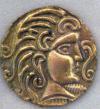Cosmic Hole In The Sky Set On Fire

Credit: ESO/APEX (MPIfR/ESO/OSO)/T. Stanke et al./Digitized Sky Survey 2
In order to better understand star formation, astronomers need telescopes that can observe at longer wavelengths, such as the submillimetre range, in which the dark dust grains shine rather than absorb light. APEX, on the Chajnantor Plateau in the Chilean Andes, is the largest single-dish submillimetre-wavelength telescope operating in the southern hemisphere, and is ideal for astronomers studying the birth of stars in this way.
Credit: ESO/Digitized Sky Survey 2. Acknowledgement: Davide De Martin
Located in the constellation of Orion (The Hunter), 1500 light-years away from Earth, the Orion Molecular Cloud Complex is the closest region of massive star formation to Earth, and contains a treasury of bright nebulae, dark clouds and young stars. The new image shows just part of this vast complex in visible light, with the APEX observations overlaid in brilliant orange tones that seem to set the dark clouds on fire. Often, the glowing knots from APEX correspond to darker patches in visible light — the tell-tale sign of a dense cloud of dust that absorbs visible light, but glows at submillimetre wavelengths, and possibly a site of star formation.
The video begins with a wide-field view of the sky in visible light, before zooming in to the constellation of Orion and the region around the reflection nebula NGC 1999, with the APEX observations overlaid in brilliant orange tones that seem to set the dark clouds on fire.
Credit: ESO/APEX (MPIfR/ESO/OSO)/T. Stanke et al./Digitized Sky Survey 2/Nick Risinger (skysurvey.org). Music: movetwo
The bright patch below of the centre of the image is the nebula NGC 1999. This region — when seen in visible light — is what astronomers call a reflection nebula, where the pale blue glow of background starlight is reflected from clouds of dust. The nebula is mainly illuminated by the energetic radiation from the young star V380 Orionis [2] lurking at its heart. In the centre of the nebula is a dark patch, which can be seen even more clearly in a well-known image (http://www.spacetelescope.org/images/opo0010a/) from the NASA/ESA Hubble Space Telescope.
Normally, a dark patch such as this would indicate a dense cloud of cosmic dust, obscuring the stars and nebula behind it. However, in this image we can see that the patch remains strikingly dark, even when the APEX observations are included. Thanks to these APEX observations, combined with infrared observations from other telescopes, astronomers believe that the patch is in fact a hole or cavity in the nebula, excavated by material flowing out of the star V380 Orionis. For once, it truly is a hole in the sky!
Credit: ESO/APEX (MPIfR/ESO/OSO)/T. Stanke et al./Digitized Sky Survey 2. Music: movetwo
The region in this image is located about two degrees south of the large and well-known Orion Nebula (Messier 42), which can be seen at the top edge of the wider view in visible light from the Digitized Sky Survey.
The APEX observations used in this image were led by Thomas Stanke (ESO), Tom Megeath (University of Toledo, USA), and Amy Stutz (Max Planck Institute for Astronomy, Heidelberg, Germany). APEX is a collaboration between the Max Planck Institute for Radio Astronomy (MPIfR), the Onsala Space Observatory (OSO) and ESO. Operation of APEX at Chajnantor is entrusted to ESO.
Anyone can join.
Anyone can contribute.
Anyone can become informed about their world.
"United We Stand" Click Here To Create Your Personal Citizen Journalist Account Today, Be Sure To Invite Your Friends.
Before It’s News® is a community of individuals who report on what’s going on around them, from all around the world. Anyone can join. Anyone can contribute. Anyone can become informed about their world. "United We Stand" Click Here To Create Your Personal Citizen Journalist Account Today, Be Sure To Invite Your Friends.
LION'S MANE PRODUCT
Try Our Lion’s Mane WHOLE MIND Nootropic Blend 60 Capsules
Mushrooms are having a moment. One fabulous fungus in particular, lion’s mane, may help improve memory, depression and anxiety symptoms. They are also an excellent source of nutrients that show promise as a therapy for dementia, and other neurodegenerative diseases. If you’re living with anxiety or depression, you may be curious about all the therapy options out there — including the natural ones.Our Lion’s Mane WHOLE MIND Nootropic Blend has been formulated to utilize the potency of Lion’s mane but also include the benefits of four other Highly Beneficial Mushrooms. Synergistically, they work together to Build your health through improving cognitive function and immunity regardless of your age. Our Nootropic not only improves your Cognitive Function and Activates your Immune System, but it benefits growth of Essential Gut Flora, further enhancing your Vitality.
Our Formula includes: Lion’s Mane Mushrooms which Increase Brain Power through nerve growth, lessen anxiety, reduce depression, and improve concentration. Its an excellent adaptogen, promotes sleep and improves immunity. Shiitake Mushrooms which Fight cancer cells and infectious disease, boost the immune system, promotes brain function, and serves as a source of B vitamins. Maitake Mushrooms which regulate blood sugar levels of diabetics, reduce hypertension and boosts the immune system. Reishi Mushrooms which Fight inflammation, liver disease, fatigue, tumor growth and cancer. They Improve skin disorders and soothes digestive problems, stomach ulcers and leaky gut syndrome. Chaga Mushrooms which have anti-aging effects, boost immune function, improve stamina and athletic performance, even act as a natural aphrodisiac, fighting diabetes and improving liver function. Try Our Lion’s Mane WHOLE MIND Nootropic Blend 60 Capsules Today. Be 100% Satisfied or Receive a Full Money Back Guarantee. Order Yours Today by Following This Link.






